|
"We suspect these
palettes were used as ritual furniture, portable alters on which
medicines and other supernaturally powerful mixtures were prepared."------2004,
Kevin E. Smith & James V. Miller, "Vincas P. Steponaitis &
Vernon J. Knight, "Moundville Art In Historical And Social Context,"
Hero Hawk, And Open Hand, p. 174.
"The vast majority of the palettes at Moundville
are made of fine, gray, micaceous sandstone that occurs in great
abundance at outcrops only 30 km (18.8 miles) north of the site."---------2004,
Kevin E. Smith & James V. Miller, "Vincas P. Steponaitis &
Vernon J. Knight, "Moundville Art In Historical And Social Context,"
Hero Hawk, And Open Hand, p. 174.
"These circular stone discs, made of many
materials, such as sandstone, slates, fine grained gneiss, etc., vary in
size from 12.5 inches to 4.5 inches in diameter."--------1957,
Emma Lila Fundaburk & Mary Douglass Foreman, "Sun Circles And Human
Hands," Stone Palettes, (no page numbers).
"Palettes of ground sandstone were made in two basic forms:
round and rectangular."----1996,
Jeffrey P. Brain and Philip Phillips, "Shell Gorgets," p. 380.
"The
designs engraved on paint palettes are characteristic symbols of the
Southern Ceremonial Complex."----1957,
Emma Lila Fundaburk & Mary Douglass Foreman, "Sun Circles And Human
Hands," Stone Palettes, (no page numbers).
"The aborigines
were skilled in preparing the mineral colors, which were usually ground
in small mortars or rubbed down on a flat stone---."----1912,
Frederick Webb Hodge, "Handbook American Indians North Of Mexico," p.
185.
"That the palettes were
used to prepare colorful minerals for some purpose is beyond dispute."----2011,
Vincas P. Steponaitis, Samuel F. Swanson, George Wheeler & Penelope B.
Drooker, "The Provenance And Use Of Etowah Palettes,"
American Antiquity, Vol. 76, No. 1, pp. 81-106.

STONE DISC PALETTES
A.D. 1150 TO 1400
SOUTHEASTERN U.S.
Stone disc
palettes are most interesting for their unique shape, craftsmanship and
level of importance they held within the Mississippian culture. The
majority of them were
discovered on the Moundville site in Alabama with the Etowah site in
Georgia coming in second. But sporadic discoveries have been reported on
several Mississippian sites in the southeastern U.S. as far west as
Missouri. They date to sometime between A.D. 1150 and 1400.
Mississippian stone disc palettes have been described in print for well over a hundred years. |
|
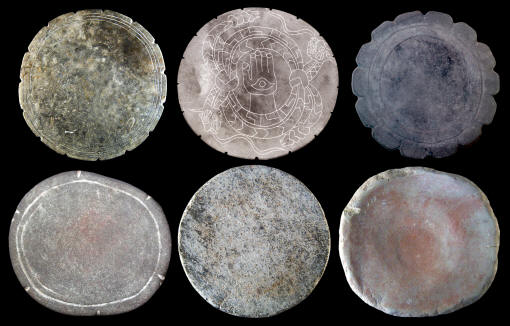
CLICK ON PICTURE FOR LARGER IMAGE
STONE DISC PALETTES
ALABAMA, ILLINOIS, MISSOURI,
TENNESSEE
These six stone disc palettes are
reported to have been found on sites in Alabama, Illinois, Missouri
and Tennessee. They are all Mississippian culture artifacts.
The disc at top left was found in 1975 during excavation of
the Campbell site in Pemiscot County, Missouri. This palette was
discovered in association with a burial along
with a large catlinite disc pipe that measures as long as the
palette is wide. It was also found with several disintegrated copper
plates and a large quantity of red ochre. The pipe was found laying
directly on top of the palette with the disc side down. The Campbell site disc has three
engraved circles near the edge on one side and two on the other. The
edge has fifteen evenly spaced notches around the perimeter and X's
are engraved on the edge between each notch. The Campbell site disc
is made of a highly fossiliferous stone that might be limestone and
it measures 7 1/2 inches (19 cm) in diameter.
The disc at top center is one of the five most intricately
engraved stone discs ever found and the most famous stone disc ever
found on the Moundville site. It's known as the "rattlesnake disc."
It was discovered sometime before 1883 by a farmer plowing his
field. The entwined serpents, open hand and central ogee symbol
represents iconography that some archaeologist believe may represent
an opening or pathway to the inter-dimensional world of the
ancestors. This stone disc palette is made of sandstone and measures
12 9/16 inches (31.9 cm) in diameter.
The disc at top right was on display in the McClung Museum in
Tennessee when it was photographed. This type is often referred to
as a notched palette. This one has fourteen very well done rounded
notches that are evenly spaced around the edge along with the
commonly seen double engraved circles near the edges.
The disc at lower left was discovered on a site in south
western Tennessee in Shelby, County on a site called either Jeter or
Benjestown. This palette is reported to have been discovered with a
burial that also contained ceramics and a highly polished
rectanguloid piece of cannel coal that was placed beneath the skull.
This palette is made of fine grained sandstone and it exhibits heavy
grinding use wear. Both sides are reported to be worn down from
rotary grinding. The center thickness is 4 mm thick and the rim
measures 7 to 8 mm thick. The diameter of this palette is 4 3/8
inches (11.1 cm). It's also reported that there are traces of a
reddish substance in the center of one side.
Very little is known about the disc at lower center. The only information is that it was once in a small
southern Indiana private collection and it appears to have once had
a tag on one side. It does seem to be an ancient artifact. It's
surface indicates that it was pecked, ground and polished into
shape. One side is fairly evenly flat. The other side has a slight
concave depth of 1/16 inch (2 mm). There is a crack in the stone
that extends towards the center for about 3 inches (7.6 cm). The
stone appears to be the
gray fine-grained micaceous sandstone that is reported from the
Moundville area. There is also a red colored residue on both sides
that may be red ochre.
The disc at lower right was excavated by Bill Fecht somewhere on the Cahokia
Mounds site in 1960. He notes that he discovered it with a burial
but gave no more specific information than that. This palette may be
unique as being one of the only complete examples found at Cahokia.
This palette is generally round in shape but it's not symmetrical.
The longer side measures 9 3/8 inches (23.8 cm) long and the
narrower side 8 5/8 inches (21.9 cm) wide. Both sides have concave
surfaces. What appears to have been the bottom side is very smooth
across the entire surface. The red stained
side exhibits uneven wear that indicates it was used for the
heaviest grinding processes. The cavity depth of the underside
measures 5/32 inch (4 mm) deep and the cavity depth of the top side
measures 3/8 inch (1 cm) deep. The edge thickness varies from 15/16
inch (2.5 cm) thick to about 5/8 inch (1.6 cm) thick. The two cuts
on the edge of the upper side of this palette were done in recent
times by Bill Fecht's excavating tools in 1960. |
|
|
Early archaeological investigators like Charles C. Jones and
William Holmes were the first to write about these unique artifacts.
Jones seems to have been the first to describe them in 1873. He
describes a "stone plate" that was "plowed up" in 1859 on the
Etowah as; "----this stone
plate, circular in form, eleven inches and a half in diameter, an inch
and a quarter in thickness, and weighing nearly seven pounds. It is made
of a close-grained, sea-green slate, and bears upon its surface the
stains of centuries. Between the rim, which is scalloped, and the
central portion, are two circular depressed rings, running parallel with
the circumference and incised to the depth of the tenth of an inch. The
central portion, or basin, is hollowed out to the depth of rather more
than the eighth of an inch. This circular basin, nearly eight inches in
diameter, is surrounded by a margin or rim, a little less than two
inches in width, transversed by the incised rings and beveled from the
center toward the edge. The lower surface or bottom of the plate is
flat, beveled upward, however, as it approaches the scalloped edges,
which is not more that a quarter of an inch in thickness." |
|
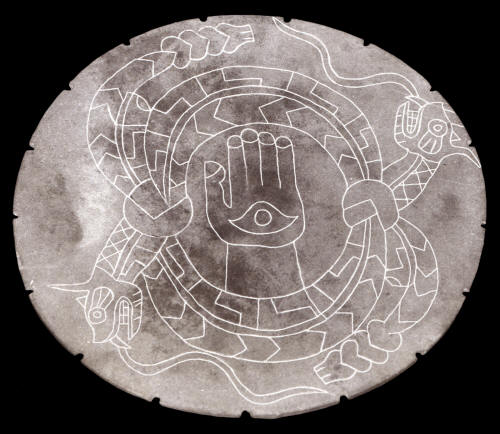
PHOTO TAKEN BY DENNIS VESPER AT MOUNDVILLE, ALABAMA IN THE 1970'S
CLICK ON PICTURE FOR LARGER IMAGE
STONE DISC PALETTE
"THE RATTLESNAKE DISC"
MOUNDVILLE SITE
HALE COUNTY, ALABAMA
This palette is known as the "rattlesnake disc." It's the most
famous stone disc palette that was ever found at Moundville. It was
originally discovered by a farmer plowing his field in Moundville
and later given as a gift to Alabama state archaeologist Professor
E. A. Smith sometime before 1883. It was then lent to the
Smithsonian National Museum where Holmes described it in 1883. After
that, sometime before 1905 it was transferred to the University of
Alabama Museum and now in the Jones Archaeological Museum at the
Moundville Archaeological Park. Holmes originally described the disc
with a cautious and skeptical view.
Holmes described the "rattlesnake disc" in 1883 as; "I have
seen in the National Museum a curious specimen of stone disk,
although there is not sufficient assurance of its genuineness to
allow it undisputed claim to a place among antiquities. It is a
perfectly circular, neatly-dressed sandstone disk, twelve inches in
diameter and one-half an inch in thickness. Upon one face we see
three marginal incised lines while on the other there is a
well-engraved design which represents two entwined or rather knotted
rattlesnakes. Within the circular space enclosed by the bodies of
the serpents is a well drawn hand in the palm of which is placed an
open eye; this would probably have been omitted by the artist had he
fully appreciated the skeptical tendencies of the modern
archaeologist. The margin of the plate is divided into seventeen
sections by small semicircular indentations. This object is said to
have been obtained from a mound near Carthage, Alabama." Clarence B.
Moore wrote in 1905 that Holmes was by then satisfied that the disc
"may be accepted without suspicion."
The entwined serpents, open hand and central ogee symbol
represents iconography that some archaeologist believe may represent
an opening or pathway to the inter-dimensional world of the
ancestors. This stone disc palette is made of sandstone and measures
12 9/16 inches (31.9 cm) in diameter. |
|
|
Stone disc palettes have been referred to by many different
names for almost 140 years. They have been described as discs, stone
discs, ceremonial discs, calendar discs, stone plates, sun discs,
notched stone discs, palettes, circular palettes, paint palettes, stone
palettes, slab palettes, plaques, and mortar plates. There is still no
specific name given to these artifacts. But in recent years either the
term disc or palette is most often used. The same issue has been raised
by archaeologists describing Hohokam palettes in the southwestern U.S.
The term "tablet" has been offered because the word palette suggests
painting or pigment processing. It is not yet clear if processing
pigments was the sole intended purpose of
Hohokam tablets, even though mineral pigments have been found on some of
them. There is some reason to believe the
Hohokam tablets may have been used for different purposes, just as some
archaeologists have suggested that Mississippian palettes may have been
used for different purposes. |
|
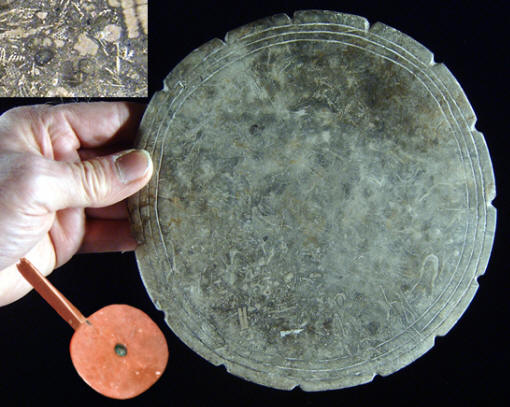
CLICK ON PICTURE FOR LARGER IMAGE
STONE DISC PALETTE
CAMPBELL SITE
PEMISCOT COUNTY, MISSOURI
This is an especially fine example of
a stone disc palette. It was excavated in 1975 on a large
Mississippian site in Pemiscot County, Missouri called the Campbell
site. This palette is most interesting because it was buried with a
late period catlinite disc pipe. The pipe dates to about the
sixteenth or seventeenth century but it's believed that the palette
dates to sometime between AD 1200 to 1400. It would appear that the
palette was an antique or heirloom object at the time of it's burial
with the pipe. This palette was discovered in association with a
burial along with a large catlinite disc pipe that measures as long
as the palette is wide. It was also found with several disintegrated
copper plates and a large quantity of red ochre. The pipe was found
laying directly on top of the palette with the disc side down. The
Campbell site disc has three engraved circles near the edge on one
side and two on the other. The edge has fifteen evenly spaced
notches around the perimeter and X's are engraved on the edge
between each notch. The Campbell site disc is made of a highly
fossiliferous stone that appears to be limestone and it measures 8 inches (15.2 cm) in diameter. |
|
|
The majority of all stone disc palettes are reported from the
area on and around the Moundville site located in northern Alabama.
Estimates of the numbers found there range up to 80. They quickly drop
in numbers on sites farther to the west. The next largest Mississippian
site to the east is Etowah in Georgia where approximately 10 complete stone discs
have been reported. Several of these were excavated by Lewis Larson from
Mound C. |
|
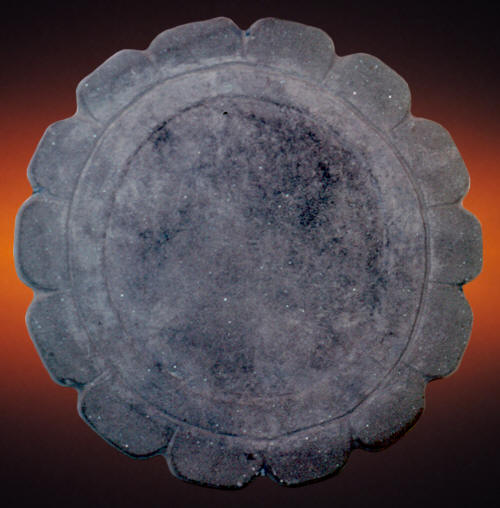
PHOTO OF PALETTE IN THE McCLUNG MUSEUM
TAKEN FROM A SLIDE THAT WAS PHOTOGRAPHED BY DENNIS VESPER IN 1985
STONE DISC PALETTE
TENNESSEE?
This
is an excellent example of a scalloped edge stone disc palette. It
was photographed a few years ago in the McClung Museum in Knoxville,
Tennessee. Its scalloped edges and engraved concentric rings is an
artistic style that mimics some shell gorgets. |
|
|
Stone disc palettes range in style from simple round flat
stones to round flat stones that were very skillfully shaped, engraved
and polished. The one similar trait that most of them seem to have is
they were manufactured into the shape of a thin round disc. But this is
not true for all of them. A very few examples have been found that are
rectangular in shape. It's interesting to note that of the thousands of
palettes that must have been made by the Hohokam culture in the
southwest, most of them were rectangular in shape and only a very few
round examples have been found. The opposite is true of the
Mississippian culture in the southeastern U.S. where, although not very
many were made, most of their palettes were round in shape. The size
range for stone disc palettes seems to be between 2 1/2 inches (6.4 cm) to
13 inches (33 cm) in diameter. |
|
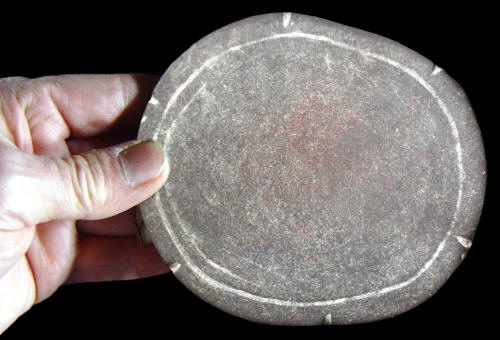
PHOTO OF PALETTE WAS TAKEN BY FRANK
ROBISON
CLICK ON PICTURE FOR LARGER IMAGE
STONE DISC PALETTE
JETER OR BENJESTOWN SITE
SHELBY COUNTY, TENNESSEE
This small "notched" stone disc palette was
found on a Mississippian site in western Tennessee and described in
a report written by Fletcher Jolly in 1972. The Mississippian
component on this site is identified as belonging to the Walls
phase. This palette is reported to have been discovered with a
burial that also contained ceramics and a highly polished
rectanguloid piece of cannel coal that was placed beneath the skull.
This palette is made of fine grained sandstone and it exhibits heavy
grinding use wear. Both sides are reported to be worn down from
rotary grinding. The center thickness is 4 mm thick and the rim
measures 7 to 8 mm thick. The diameter of this palette is 4 3/8
inches (11.1 cm). It's also reported that there are traces of a
reddish substance in the center of one side. |
|
|
There appears to be two basic groups of stone discs, those that have
heavy grinding use-wear and those that show little wear. Many of the
more simple sandstone discs have obvious use-wear depressions on
one or both sides indicating a grinding process. But the more elaborate and highly engraved examples seem to
have less wear. In fact some of these surfaces are sometimes polished. It would
appear that some palettes were much more heavily used to process mineral
pigments than others. The more elaborate examples may have been
protected from to much wear by using already processed pigments. Some
palettes may have been painted or maybe they were being used like one of
today's modern artists palettes to hold and mix the already processed
paint. |
|
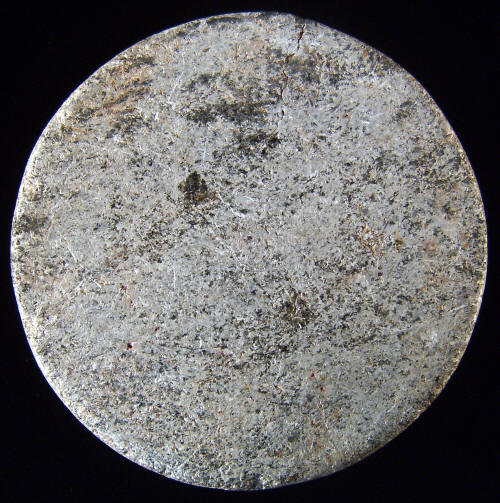
CLICK ON PICTURE FOR LARGER IMAGE
STONE DISC PALETTE
SOUTHERN INDIANA?
Very little is known about this stone
disc palette. The only information is that it was once in a small
southern Indiana private collection and it appears to have once had
a tag on one side. It does seem to be an ancient artifact. It's
surface indicates that it was pecked, ground and polished into
shape. One side is fairly evenly flat. The other side has a slight
concave depth of 1/16 inch (2 mm). There is a crack in the stone
that extends towards the center for about 3 inches (7.6 cm). The
stone appears to be the
gray fine-grained micaceous sandstone that is reported from the
Moundville area. There is also a red colored residue on both sides
that may be red ochre.
It's possible that this palette may have been made by a
Moundville craftsman since it's made of what may be stone from that
area in northern Alabama. This palette doesn't have any carved or
notched edges or engraved lines but there are plain stone discs
reported from the Moundville area. |
|
|
There has been much speculation as to the purpose of stone disc
palettes. Over the years, writers have suggested they may have been used
as plaques to commemorate intertribal treaties, a tool that was used to
ritually prepare such things as tobacco or some type of hallucinogenic
drug or even as plates to offer food to the sun god. But the most
logical and partially provable theory has been that they were used as paint palettes. Since
most of them have been found with traces of mineral pigment still
adhering to one side this idea may be closest to the truth. |
|
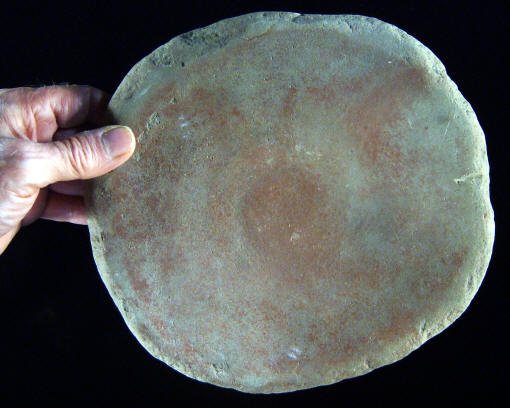
CLICK ON PICTURE FOR LARGER IMAGE
STONE DISC PALETTE
CAHOKIA MOUNDS SITE
MADISON / ST. CLAIR COUNTIES,
ILLINOIS
This large stone
disc palette was excavated by Bill Fecht somewhere on the Cahokia
Mounds
site in 1960. He notes that he discovered it with a burial but gave
no more specific information than that. This palette may be unique
as being one of the only complete examples found at Cahokia. Unlike
the discoveries of large stone disc palettes on Mississippian sites
farther to the south and east they are almost unknown as far
north as The Cahokia Mounds site.
This stone disc is made of fine grain sandstone. There seems
to be no doubt that it was used as a palette to grind and process
mineral pigments. The upper surface indicates heavy use wear from
grinding and it is deeply stained from a mineral pigment. It was
apparently being used to process red ochre from hematite iron oxide.
This palette is generally round in shape but it's not
symmetrical. The longer side measures 9 3/8 inches (23.8 cm) long
and the narrower side 8 5/8 inches (21.9 cm) wide. Both sides have
concave surfaces. What appears to have been the bottom side is very
smooth across the entire surface. The red stained
side exhibits uneven wear that indicates it was used for the
heaviest grinding processes. The cavity depth of the underside
measures 5/32 inch (4 mm) deep and the cavity depth of the top side
measures 3/8 inch (1 cm) deep. The edge thickness varies from 15/16
inch (2.5 cm) thick to about 5/8 inch (1.6 cm) thick. The two cuts
on the edge of the upper side of this palette were done in recent
times by Bill Fecht's excavating tools in 1960. |
|
|
Research has shown that Mississippian stone disc palettes contain
residue from several different types of mineral pigments. A recently
published report (2011) investigating Etowah site palettes
identified at least six different substances. The identified mineral
pigments are kaolinite (a clay mineral, color white), calcite (possibly
burned & processed mussel shells, color white), hematite (one of
several different types of iron oxides, color red), graphite (a
type of coal, color black), and galena (when weathered it turns
into cerrusite which is white but galena (lead) is gray when freshly
ground). The other residue that was found on Etowah palettes was
resin. This material is reported to be a yellowish-brown color that
sometimes covers large areas on some of the palettes. Under
magnification the material appears to have a "bubbly" shape which
indicates it was once a viscous material. |
|
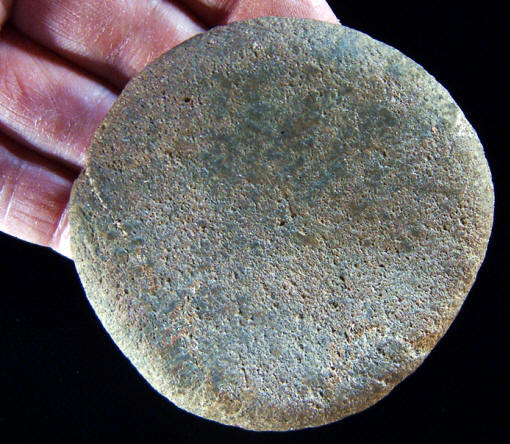
SMALL STONE DISC PALETTE
SCHAEFER SITE
MONROE COUNTY, SOUTHERN ILLINOIS
This small stone disc
palette was found in a cultivated field on a large Mississippian site in
southern Illinois near the Mississippi River by Liz Kassly. It's a nice
example of a very small disc palette. This example appears
to have been deliberately shaped into a thin round grinding stone by
pecking and grinding. This palette exhibits heavy use wear in the form
of grinding in the center of one side to a depth of 1/8 inch (3 mm). The
other side has a shallower concavity that was also apparently caused
from grinding. This palette measures 2 7/8 inches (7.3 cm) in diameter
and it has a maximum edge thickness of 9/16 inch (1.4 cm). Both sides
have traces of a red color residue that may
indicate this tool was used to process red ochre pigment. The small
pebble-pestle pictured below was found near by this palette and may have
once belonged together in a "kit." |
|
|
The majority of all stone disc palettes found at Moundville
were made of gray fine-grained micaceous sandstone. It's been determined
that the micaceous sandstone from which they were made was quarried
from the Upper Pottsville Formation near the Fall Line at Tuscaloosa
only 30 km north of Moundville. Other materials that were used to make
stone disc palettes include limestone, gneiss, phyllite, sandstone,
shale and slate. |
|
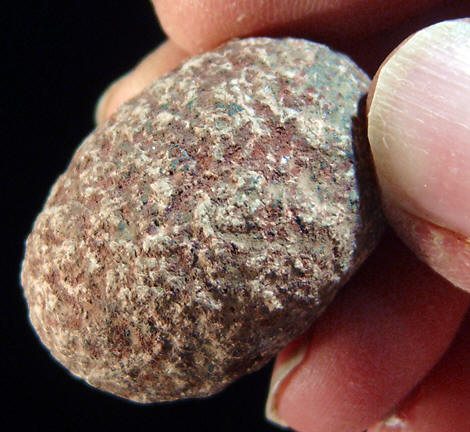
SMALL STONE PESTLE
USED TO GRIND HEMATITE
SCHAEFER SITE
MONROE COUNTY, SOUTHERN ILLINOIS
This simple stone pebble was found by Liz
Kassly nearby the stone disc palette pictured above. It's possible
that they were both once used together. The deep red material
is most probably red ochre pigment that was processed from pieces of
hematite iron ore. |
|
|
Stone disc palettes are often found in association with
graves. The more elaborate examples have been found with burials of
important individuals who were placed in mounds, such as Mound C at
Etowah. Recent examination by Steponaitis, Swanson, Wheeler & Drooker of
ten palettes from Etowah indicate that several of them were buried in
bundles. They were found in inverted (upside-down) positions on top of
and in direct contact with unprocessed pigments in the form of galena
and graphite pebbles and hematite and calcite (possibly shell).
Preserved fabric remnants on some of the palettes indicate they were
wrapped as "kits" and buried as bundles. |
|
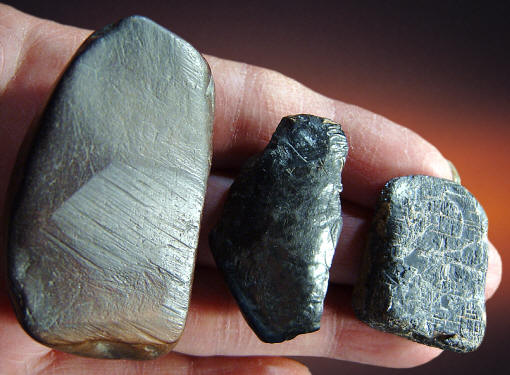
MINERAL PIGMENTS
SOUTHERN ILLINOIS SITES
These three stones were surface collected
on cultivated fields in southern Illinois. They represent three
different minerals that were used to make paint pigments. The
example on the left is a piece of hematite which is a material that
was used to produce red ochre pigment. Grinding striation lines on
this sample indicates that it may have been used in a pigment
manufacturing process. Red ochre is the most common mineral pigment
that has been observed on the surface of Mississippian disc
palettes. The middle stone is a piece of cannel coal that could be
used to produce a black pigment if it's ground into a powder. The
mineral on the right is galena lead sulphide. Some Mississippian
period palettes have a white surface residue that has been
identified as cerrusite. Cerrusite is lead carbonate which is formed
from the weathering process of galena. Lead is believed to be the
second most commonly identified surface residue on Mississippian
palettes. |
|
|
It's interesting to note that Brain and Phillips points out
that "only five (figural designed) engraved palettes are known." These
are the examples that have "classic" Mississippian iconography engraved
on them in the form of serpents, spider, open hand, ogee symbol (eye),
bilobed arrow, skull and conch shell symbol. They were found over a wide
area. One is reported from Moundville (Alabama), one from Etowah
(Georgia), one from Arkansas and two from Mississippi. The imagery that
was engraved on these five palettes represents a blend of inter-regional
Mississippian iconography that appears on sites from Etowah, Georgia in
the east to Spiro, Oklahoma in the west. |
|
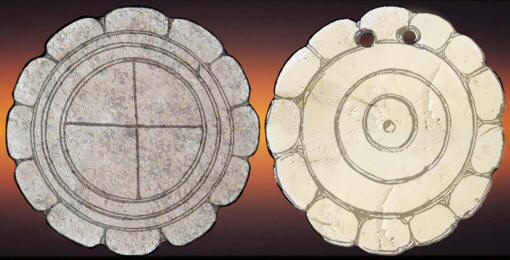
LINE DRAWING ILLUSTRATIONS
FROM 1883 "Art In Shell Of
The Ancient Americans," SECOND
Annual Report Of The Bureau Of Ethnology Of The Secretary Of The
Smithsonian Institution
LINE DRAWINGS OF A DISC
PALETTE
AND A SHELL GORGET
TENNESSEE
These two line drawings illustrate the
similarity of design that is seen between some stone disc palettes
and shell gorgets. Both of these have a scalloped edge and three
engraved concentric circles. All of the various types of sculpted
and engraved design patterns that are seen on Mississippian palettes
have been observed on shell gorgets and dippers. Some of the imagery
was also applied to some ceramic pots and ground stone discoidals. |
|
|
No one may ever know exactly how the most elaborately crafted stone disc
palettes were used. But we do know what they are made of and that they
were important enough to be placed into mounds with "elite" individuals
and that their surfaces came into contact with several different colors
of mineral pigments. Some of them even contain imagery that suggests
mythological ideas that may involve the sole and interdimensional
portals. But even though stone disc palettes still remain somewhat
mysterious we know that as the years go by more and more information
about these intriguing objects will continue be added to the
archaeological record. |
|
"REFERENCES"
1873, Jones, Charles C., "Antiquities
Of The Southern Indians, Particularly Of The Georgia Tribes," pp.
373-376.
1883, Holmes, William H., "Art In
Shell Of The Ancient Americans," Second Annual Report Of The Bureau Of
Ethnology Of The Secretary Of The Smithsonian Institution, 1880-81, pp.
277-279.
1905, Moore, Clarence. B., "Certain Aboriginal Remains Of The Black
Warrior River," Journal Of The Academy Of Natural Sciences Of
Philadelphia, pp. 125-244.
1912, Frederick Webb Hodge, "Handbook
American Indians North Of Mexico," p. 185.
1957, Fundaburk, Emma Lila & Foreman,
Mary Douglass "Sun Circles And Human
Hands," Stone Palettes,
(no page numbers).
1965, Gladwin, Harold S., Haury, Emil W., Sayles, E. B., Gladwin,
Nora, "Excavatons At Snaketown, Material Culture," pp. 121-126.
1972, Jolly, Fletcher III & Brendel, Shirley, "Two Notched Stone
Disks From The Mississippi Valley Of West Tennessee," Tennessee
Archaeologist, Vol. XXVIII, No. 1, pp. 1-10.
1996,
Brain, Jeffrey P. & Phillips, Philip, "Shell Gorgets," p. 380.
2002, Whitney, Cynthia, Steponaitis, Vincas P., Rogers, John J,
W., "A Petrographic Study Of Moundville Palettes," Southeastern
Archaeology, Vol. 21, no. 2, pp. 227-234.
2004, Smith, Kevin E. & Miller, James V., Steponaitis, Vincas P. &
Knight, Vernon J. "Moundville Art In Historical And Social Context,"
Hero Hawk, And Open Hand, p. 174.
2010, White, Devin Alan, "Hohokam Palettes From The Gila Bend
Region," Journal Of The Southwest, July 1, 2010.
2011, Steponaitis, Vincas P., Swanson, Samuel F., Wheeler, George
& Drooker, Penelope B., "The Provenance And Use Of Etowah Palettes,"
American Antiquity, Vol. 76, No. 1, pp. 81-106.
2011, Davidson, Scott, "The Campbell Site Disc: A Moundville
Treasure In Southeastern Missouri," Prehistoric American, Vol. XLV,
No. 3, pp.33-35.
Personal Communication with Dennis Vesper
Personal Communication with Jim Marlen
Personal Communication with Frank Robison
|
|
RECENT
LISTINGS HOME
ORDERING |